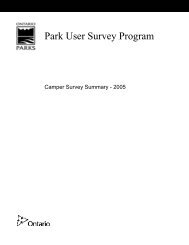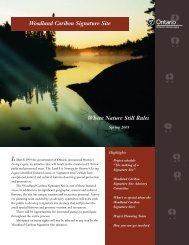Vegetation Plan - Ontario Parks
Vegetation Plan - Ontario Parks
Vegetation Plan - Ontario Parks
Create successful ePaper yourself
Turn your PDF publications into a flip-book with our unique Google optimized e-Paper software.
APPENDIX 4: Use of Sand Fencing<br />
Sand fencing can be used in the beach and foredune to help stop sand from accumulating in undesirable areas.<br />
The following guidelines are taken from Peach (2005).<br />
• Fencing requires 40% - 50% porosity for optimum sand accumulation;<br />
• Wood slat snow fencing is preferable; plastic fencing is prone to decay from ultraviolet radiation;<br />
• Fencing is used to slow the onshore wind speeds, allowing sand to accumulate behind the<br />
fence;<br />
• The rule of thumb for sand fencing placement is, “Significant sand deposition will occur in an<br />
area behind the fence measuring about eight times the height of the fence.” (i.e., a one-metrehigh<br />
fence will have significant accumulations eight metres behind it);<br />
• Fencing can be placed during the fall before Thanksgiving weekend and removed in the spring<br />
prior to peak tourist season. It can be used all year as well;<br />
• When water levels are low, multiple rows of fencing can be used;<br />
• Note: In areas with Pitcher’s Thistle where this management technique is used, sand<br />
accumulation should be monitored as Pitcher’s Thistle is tolerant of sand accumulations of only<br />
2-3 cm per year;<br />
• It will also be important to monitor sand accumulations and adjust fences accordingly;<br />
• Newly accumulated sand will be loose and susceptible to erosion, and consideration may be<br />
given to using this technique in combination with planting to give the accumulated sand stability;<br />
(See Appendix 5)<br />
• Sand fencing is generally used for the first 2-3 years of the project until vegetation has been<br />
established sufficiently to act as the primary sand-trapping mechanism.<br />
34
















